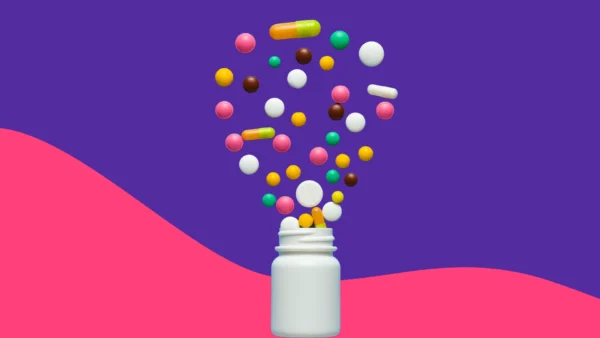Key takeaways
Chronic headaches affect a significant percentage of people, many of whom rely on over-the-counter (OTC) medications for relief.
Pharmacists can provide recommendations on OTC medications for headache relief as well as help identify medication-related causes of chronic headaches.
However, overuse of headache medications can actually worsen headaches, making it important for pharmacists to help patients find appropriate solutions.
Pharmacists play a key role in knowing when to refer patients for further evaluation of chronic headaches, such as if the patient is experiencing unusual headache symptoms.
Everyone gets a headache from time to time. According to the World Health Organization (WHO), an estimated 50%–75% of adults have had at least one headache in the past year. However, some people get headaches more frequently. Headaches are considered chronic if you experience 15 or more headache episodes per month for at least three months. Chronic headaches affect 1.7%–4% of adults globally, also according to the WHO.
Many people with recurrent headaches rely on over-the-counter (OTC) medications. In the U.S. and U.K., only half of people with migraines have seen a healthcare provider for their headaches in the past year, and only two-thirds have been diagnosed correctly, per the WHO. However, OTC pain relievers may not be the best solution for chronic headaches—and overuse of these medications can make headaches worse.
As a pharmacist, you have an opportunity to help people find relief or refer them to a healthcare provider when appropriate. Pharmacists can suggest non-pharmacological and over-the-counter treatments to patients deemed eligible for self-care. This article aims to help pharmacists refresh their knowledge to effectively counsel patients on how to manage chronic headaches.
Types of headache
When patients seek your advice on how to treat chronic headaches, ask about their symptoms and where their head hurts. Ask how often they experience headaches and what they think is causing them. Gathering this information may help determine the type of headache, which can guide your treatment or referral recommendations.
Headache disorders are either primary or secondary. Primary headache disorders have no other cause, while secondary headaches can be attributed to another condition or cause, and the headache is just a symptom. Regardless of whether they are primary or secondary, most headaches fall into one of three main categories: tension headache, migraine headache, or cluster headache.
- Tension headaches are often brought on by stress. Symptoms typically include pressure or tightness around both sides of the head. The pain is usually mild to moderate and steady. The pain and tightness can also affect the neck and shoulder muscles.
- Migraine headaches cause moderate to severe pain that usually only affects one side of the headache. The pain may be dull, throbbing, or pulsating. Other symptoms may occur, such as nausea, vomiting, blurred vision, and sensitivity to light or sound. Migraines are more common in females than males.
- Cluster headaches occur in “clusters,” with multiple headaches a day, followed by headache-free periods. The pain is sudden and severe, usually affecting one side of the head. Other symptoms may include watery eyes, runny nose, eyelid drooping or swelling, and restlessness. Cluster headaches are more common in males.
Some people develop chronic headaches, which are not specific types of headache disorders but rather describe the frequency or, in some contexts, the duration. Chronic headache refers to headaches occurring on more than 15 days each month for at least three months. Chronic headaches are usually tension-type or migraines. For some people, these headaches occur daily and may last for hours.
Medication-related headaches
As pharmacists, you can help patients and caregivers determine medication-related causes of chronic headaches. By identifying factors causing or contributing to headaches, patients can take steps to manage them better or avoid them.
Headache-inducing medications
As patients seek your advice for headaches, use the opportunity to update their medication list and check their profile for potential causes. Many prescription drugs cause headaches as a common side effect.
When reviewing the potential side effects of prescription medications, “headache” often tops the list. However, certain classes of drugs may be more likely to cause headaches than others, especially if taken every day.
For example, vasodilators like Nitrostat (nitroglycerin) and antihypertensive agents, such as Diovan (valsartan), are known to cause headaches. Also, medications for pulmonary arterial hypertension, such as Uptravi (selexipag), may induce headaches due to their vasodilation effect.
Frequent headaches could also be a sign of a missed dose or lack of adherence to certain medications. For instance, patients may experience headaches and other uncomfortable withdrawal-like symptoms if they miss doses of an antidepressant like Paxil (paroxetine). To help assess adherence, check patients’ refill history and ask how they remember to take their medications. Suggest using pill organizers, medication reminders, or alarm clocks to help patients stay adherent.
Medication overuse headache
Ask patients living with chronic headaches about the OTC and prescription medications they take for headache relief and how often they take them.
Medication overuse headache (MOH) occurs when people take acute headache medications often, leading to a vicious cycle of rebound headaches. This can happen with both prescription and non-prescription headache medications.
MOH may cause tension-type or migraine symptoms. This type of headache may occur daily or nearly daily and can be caused by several medications, including analgesics. Analgesics, such as non-steroidal anti-inflammatory drugs (NSAIDs) and acetaminophen, can cause MOH when a patient takes more than the recommended daily doses and/or takes the analgesics ten or more days per month.
The risk of MOH is highest with:
- Opioid analgesics
- Combination drugs containing butalbital, such as Fioricet
- Combination medications containing acetaminophen/aspirin/caffeine, such as Excedrin
RELATED: Medication overuse headaches, explained
Non-pharmacologic options
Talk with your patients about lifestyle factors that could be contributing to their headaches. Several lifestyle modifications may be beneficial for people with chronic headaches, such as:
- Hydrate with plenty of fluids every day.
- Get adequate sleep.
- Avoid dietary triggers.
- Exercise regularly, as appropriate for your fitness level.
- Limit caffeine intake.
- Manage stress and make time for self-care.
Pharmacists can also encourage patients to track their headaches in a journal or health app. Recording headaches, symptoms, severity, and treatments can help patients and their healthcare providers evaluate whether the current treatment plan is working or if adjustments are necessary.
Pharmacists can also make a difference by counseling patients about the risks of overusing migraine and headache medications. Research shows that simply educating patients about the potential risks of medication overuse headaches and medication withdrawal can reduce the frequency of headaches in patients with medication overuse headaches. Simple advice from a healthcare professional can lead to a reduction in medication use and an improvement in headache symptoms in patients with MOH.
OTC headache treatments
Common OTC medications used to treat headache pain include:
- NSAIDs, such as Motrin (ibuprofen) or Aleve (naproxen), can effectively treat headache pain. Do not recommend NSAIDs for patients with cardiovascular problems, kidney impairment, or a history of gastrointestinal bleeding.
- Tylenol (acetaminophen) can be recommended first-line for patients with headaches who cannot take NSAIDs.
- Excedrin Migraine (acetaminophen, aspirin, and caffeine) is beneficial in relieving headache pain. In a study of tension-type headaches, this combination product provided headache relief better and faster than acetaminophen alone—and allowed patients to resume their daily routines more quickly.
As a pharmacist, patients will ask for your recommendation on the best OTC medication for relieving headaches. As always, before making a specific recommendation, pharmacists should review the patient’s other medications, allergies, and underlying conditions.
Prescription medications
Prescription medications are used to manage headaches when non-pharmacologic and OTC options do not provide adequate relief. Two main types of prescription treatments are available for chronic headaches: prophylaxis to prevent headaches before they begin and abortive treatments to ease or stop headaches after they start. Common examples are described below.
Prevention
Healthcare providers may prescribe the following medications to help prevent migraine headaches:
- Beta blockers, such as Tenormin (atenolol), Lopressor (metoprolol tartrate), or Toprol XL (metoprolol succinate, extended-release).
- Antidepressants, such as Elavil (amitriptyline), Pamelor (nortriptyline), or Effexor (venlafaxine).
- Anticonvulsants such as Topamax (topiramate) or Depakote (divalproex).
Treatment
Triptans are a mainstay of acute treatment for migraine headaches. Examples of triptans include Imitrex (sumatriptan), Zomig (zolmitriptan), and Maxalt (rizatriptan). Healthcare providers prescribe triptans for stopping migraine headaches that are moderate to severe or have not been relieved with analgesics.
Migranal (dihydroergotamine) and Ergomar (ergotamine) are ergotamine derivatives used for the acute treatment of severe headaches.
Triptans and ergotamines have vasoconstrictive effects, so they should generally be avoided in patients with cardiovascular disease or uncontrolled hypertension. These medications also have significant drug interactions.
Analgesics may also be prescribed to treat headache pain on a short-term basis.
Newer therapies
Small molecule CGRP receptor antagonists are a newer drug class prescribed for prophylaxis and abortive treatment of headaches. Examples include Ubrelvy (ubrogepant), Nurtec (rimegepant), include Zavzpret (zavegepant). Unlike triptans, these medications do not have vasoconstrictive effects.
Another newer treatment is the selective serotonin receptor agonist Reyvow (lasmiditan). This medication is abortive only.
When to refer
Pharmacists can play a key role in knowing when to refer patients to see a healthcare provider for further evaluation of chronic headaches. While rare, recurrent headaches may indicate a more serious condition. The following characteristics serve as red flags, typically warranting a referral to a healthcare provider or specialist if the patient meets one or more of the following criteria:
- Patient takes OTC analgesics for headaches more than three days per week.
- Patient has had a headache for 10 days or longer.
- Patient says the headache began following a head injury or accident.
- Patient is 55 years or older and experiencing headache symptoms or patterns that they do not usually have.
- Patient’s headache begins within hours of stopping a particular medication.
- Patient is a child or adolescent.
- Patient is pregnant or breastfeeding.
Additionally, pharmacists should refer patients who present with headaches and concurrent symptoms of:
- Fever
- Shortness of breath
- Stiff neck
- Rash
- Dizziness
- Seizures
- Confusion
- Vision changes
- Numbness
- Falling
- Difficulty speaking or moving
Headaches are the most common type of pain, often requiring intervention with OTC medication. Pharmacists can play a key role in chronic headache management, including recommending OTC medications, lifestyle modifications, or counseling about the risk of medication overuse headaches. Pharmacists can also recognize when a patient may need specialized care and refer them to a healthcare provider for personalized medical advice.
Sources
- Headache disorders, World Health Organization (2016)
- Chronic headaches, StatPearls (2023)
- Patient education: Headache causes and diagnosis in adults (Beyond the Basics), UpToDate (2023)
- Chronic daily headache: Diagnosis and management, American Academy of Family Physicians (2014)
- Medication-overuse headache—a review of different treatment strategies, Frontiers in pain research (2023)
- What medications are commonly linked to headache?, American Migraine Foundation (2023)
- Lifestyle changes for migraine management, American Migraine Foundation (2021)
- Medication-overuse headache—a review of different treatment strategies, Frontiers in Pain Research (2023)
- Headaches during pregnancy, American Pregnancy Association (2023)
- Acute migraine headache: Treatment strategies, American Academy of Family Physicians (2018)
- Cluster headache: Rapid evidence review, American Academy of Family Physicians (2022)
- VA/DoD clinical practice guideline for the management of headache- Provider summary Department of Veterans Affairs (2023)
- Beta-blockers for the prevention of headache in adults, a systematic review and meta-analysis, PloS one (2019)
- Antidepressants for preventive treatment of migraine, Current treatment options in neurology (2019)
- Use of a fixed combination of acetylsalicylic acid, acetaminophen, and caffeine compared with acetaminophen alone in episodic tension-type headache: Meta-analysis of four randomized, double-blind, placebo-controlled, crossover studies, The Journal of Headache and Pain (2014)
- CGRP receptor antagonists: an expanding drug class for acute migraine?, Expert Opinion on Investigational Drugs (2016)
- Small-molecule CGRP receptor antagonists: A new approach to the acute and preventive treatment of migraine, Medicine in Drug Discovery (2020)
- Lasmiditan mechanism of action–review of a selective 5-HT 1F agonist, The Journal of Headache and Pain (2020)
- The American Headache Society position statement on integrating new migraine treatments into clinical practice, Headache (2019)
- Common presentations of chronic daily headache in adolescents. Pediatric Annals (2010)











